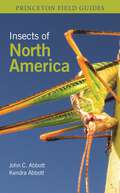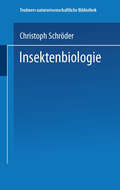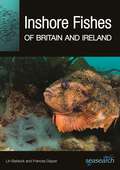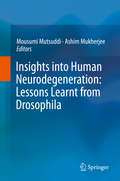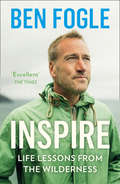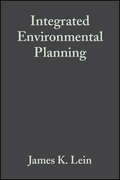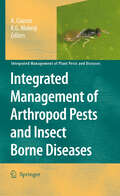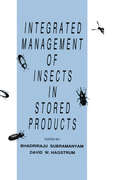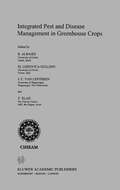- Table View
- List View
Insects of Ireland: An Illustrated Introduction Ireland's Butterflies, Ladybirds, Shieldbugs, Ants And Other Groups
by Stephen McCormack Eugenie Regan Chris ShieldsOver 11,000 species of insects occur in Ireland but most are very small and escape notice. Identifying them accurately can be difficult or impossible. This comprehensive compact guide to over 120 of Ireland’s most popular insects includes all Irish species of butterflies, bumblebees, dragonflies, ladybirds, grasshoppers and shield bugs. All are illustrated in colour with clear descriptions enabling accurate identification.
Insects of North America (Princeton Field Guides #157)
by Dr. John C. Abbott Kendra K. AbbottThe ultimate photographic field guide to North American insectsThis amazing field guide enables you to identify all 783 families of insects currently recognized in the United States and Canada. Richly illustrated with more than 3,700 stunning photos along with keys to families for many of the orders, Insects of North America features a comprehensive introduction that discusses classification and nomenclature, insect diversity, global threats, the latest collecting and curatorial techniques, and the many ways these remarkable organisms impact society. Combined with in-depth taxonomic coverage, this is the essential resource for both professionals and amateurs interested in the most diverse group of animals on the planet.Covers all 783 insect families known to occur in the United States and CanadaFeatures more than 3,700 color photos, with nearly every photo identified to species levelIncludes an illustrated glossary for easy reference in the fieldThe first field companion of its kind since the publication of the Peterson guide in 1970Ideal for entomology courses of all levelsAn invaluable resource for anyone interested in insects
Insects: A Very Short Introduction (Very Short Introductions #1)
by Simon LeatherTo date, more than a million insect species have been described, with probably at least another 5-8 million species waiting in the wings for a name. Insects are a fascinatingly diverse and beautiful spectrum of animals. They range in size from the tiny parasitic wasp, measuring a mere 139µm, to the aptly named Titan beetle, which can reach lengths of up to 17cm. They can be found on all continents of the world, from the Sahara Desert to the frozen wastes of Antarctica; in caves, under the ground, inside plants, other insects and vertebrates, in rivers, streams, lakes and ponds, in puddles, in the watery interiors of pitcher plants; and in our houses. While no insects live beneath the waves, the intrepid sea skaters skim the surface of some of the world's oceans. This Very Short Introduction explores the extraordinary world of insects. It analyses insect evolution, taxonomy and development, and describes their behaviour, their life styles, and the interactions they have with other insects and other animals. As Simon Leather shows, insects are the bedrock on which human civilisation rests; without them we would almost certainly not exist. Although they can be seen as pests of our crops plants, they are also invaluable for pollinating our flowering plants and are an invaluable link in all land ecosystems. As they face challenges from climate change and pesticides it has never been more important to understand these oft-dismissed creatures. Very Short Introductions: Brilliant, Sharp, Inspiring ABOUT THE SERIES: The Very Short Introductions series from Oxford University Press contains hundreds of titles in almost every subject area. These pocket-sized books are the perfect way to get ahead in a new subject quickly. Our expert authors combine facts, analysis, perspective, new ideas, and enthusiasm to make interesting and challenging topics highly readable.
Insects: A Very Short Introduction (Very Short Introductions)
by Simon LeatherTo date, more than a million insect species have been described, with probably at least another 5-8 million species waiting in the wings for a name. Insects are a fascinatingly diverse and beautiful spectrum of animals. They range in size from the tiny parasitic wasp, measuring a mere 139µm, to the aptly named Titan beetle, which can reach lengths of up to 17cm. They can be found on all continents of the world, from the Sahara Desert to the frozen wastes of Antarctica; in caves, under the ground, inside plants, other insects and vertebrates, in rivers, streams, lakes and ponds, in puddles, in the watery interiors of pitcher plants; and in our houses. While no insects live beneath the waves, the intrepid sea skaters skim the surface of some of the world's oceans. This Very Short Introduction explores the extraordinary world of insects. It analyses insect evolution, taxonomy and development, and describes their behaviour, their life styles, and the interactions they have with other insects and other animals. As Simon Leather shows, insects are the bedrock on which human civilisation rests; without them we would almost certainly not exist. Although they can be seen as pests of our crops plants, they are also invaluable for pollinating our flowering plants and are an invaluable link in all land ecosystems. As they face challenges from climate change and pesticides it has never been more important to understand these oft-dismissed creatures. Very Short Introductions: Brilliant, Sharp, Inspiring ABOUT THE SERIES: The Very Short Introductions series from Oxford University Press contains hundreds of titles in almost every subject area. These pocket-sized books are the perfect way to get ahead in a new subject quickly. Our expert authors combine facts, analysis, perspective, new ideas, and enthusiasm to make interesting and challenging topics highly readable.
Insekten - Erfolgsmodelle der Evolution: Faszinierend und bedroht
by Werner Gnatzy Jürgen TautzIm Laufe der Evolution haben die Insekten eine schier unglaubliche Formenvielfalt und funktionelle Raffinesse entwickelt. Das Design ihres Außenskeletts ist so phantasievoll und ungewöhnlich, oft auch bizarr, dass man nur staunen kann. Dass Insekten für jedes noch so spezielle Problem Konstruktionslösungen finden können, macht sie überaus erfolgreich. Sie wurden so zu entscheidenden Bindegliedern in den komplexen Netzwerken der Natur. Beindruckende Makroaufnahmen und informative rasterelektronenoptische Bilder geben einen Einblick in Formenreichtum, Schönheit und Funktion der Sechsbeiner. Spannende Texte begleiten die Bilder und erklären u.a. wie der Gelbrandkäfer Wirbeltierhormone als K.O.-Tropfen einsetzt, wenn er von Fischen angegriffen wird, der Kiefernprachtkäfer weit entfernte Waldbrände lokalisiert, der Bombardierkäfer mit seinem Schussapparat gepulste Explosionen abgibt oder die Bläulingsraupe Ameisen bezirzt. In den Ökosystemen unseres Planeten spielen die Insekten eine entscheidende Rolle. Die menschengemachte Umweltzerstörung greift empfindlich in diese Kreisläufe ein. Das gefährdet das Überleben der Insekten, mit dramatischen Auswirkungen auch für uns Menschen.
Insektenbiologie (Teubners naturwissenschaftliche Bibliothek)
by Christoph SchröderDieser Buchtitel ist Teil des Digitalisierungsprojekts Springer Book Archives mit Publikationen, die seit den Anfängen des Verlags von 1842 erschienen sind. Der Verlag stellt mit diesem Archiv Quellen für die historische wie auch die disziplingeschichtliche Forschung zur Verfügung, die jeweils im historischen Kontext betrachtet werden müssen. Dieser Titel erschien in der Zeit vor 1945 und wird daher in seiner zeittypischen politisch-ideologischen Ausrichtung vom Verlag nicht beworben.
Insektenwunderwelt - Einstieg in die Entomologie
by Michael SchmittSie interessieren sich für Insekten, aber die Lehrbücher der Entomologie sind Ihnen zu dick, zu teuer und zu kompliziert? Dieses Buch lässt Sie vieles über die faszinierende Vielfalt der Insekten erfahren.Es gibt Insekten wie Sand am Meer, große und kleine, schöne und hässliche, erfreuliche und lästige, nützliche und schädliche. Einige, wie die Küchenschaben, lösen Ekel aus, andere, wie die Siebenpunkt-Marienkäfer gelten als Glückssymbole, wieder andere, wie die Wespen, ängstigen uns, während die meisten Schmetterlinge wegen ihrer Farben- und Formenpracht bewundert werden. Was aber Insekten befähigt, zu laufen, zu springen, zu fliegen, wozu sie Menschenblut benötigen, wie aus einem Ei ein vollständiger Sechsbeiner wird, welchen Stellenwert Insekten im Haushalt der Natur einnehmen, erschließt sich nicht unmittelbar durch Beobachten lebender Tiere. Neben dem äußeren Erscheinungsbild werden der Körperbau und Funktionen der Organe ebenso wie Verhalten, ökologische Rolle, natürliches System und Stammesgeschichte der Insekten allgemeinverständlich und doch wissenschaftlich exakt dargestellt.
Inshore Fishes of Britain and Ireland (Wild Nature Press #33)
by Lin Baldock Frances DipperA beautifully illustrated photographic identification guide to the common marine fish found around Britain and Ireland—ideal for divers, snorkellers, and natural history enthusiastsFish are a colourful and important part of inshore marine life, much admired by divers and snorkellers. But it can be difficult to accurately identify and record these quick-moving animals underwater. This authoritative, beautifully illustrated photographic guide offers a practical, easy-to-use approach for identifying the fish species commonly seen in the waters around Britain and Ireland, as well as a few vagrant and interesting rare species. The book’s concise text explains how fish can be identified underwater, and is accompanied by numerous photographs of each species in its natural environment and diagrams illustrating key features. The book also clearly indicates the cases when underwater species identification is more difficult. Published in association with the UK’s Marine Conservation Society, the book makes an invaluable addition to the series of marine photographic titles of Seasearch, a species recording project for volunteer sports divers.Features individual descriptions of more than 150 species, with information on size, depth range, habitat and distribution in the Seasearch guide icon formatIllustrates every species in its natural underwater environmentEmphasises key identification features and possible confusion speciesIncludes a “confidence guide” distinguishing between easily recognisable species and those requiring closer examinationFeatures longer sections highlighting interesting species, behaviours and other topicsProvides information on protected species, taxonomy, shifting distributions and conservation status
Inside Nature’s Giants
by David DuganWith a foreword by Richard Dawkins, and based on the BAFTA award-winning Channel 4 TV series, Inside Nature’s Giants gets under the skin of the largest animals on the planet. See them as you've never seen them before – from the inside out.
Insight into Influenza Viruses of Animals and Humans
by Sanjay Kapoor Kuldeep DhamaThis book provides salient information on all aspects of influenza/flu viruses affecting animals and humans. It specifically reviews the properties and replication of influenza viruses; their evolution and emergence; epidemiology; role of migratory birds in disease transmission; clinical signs in humans, animals and poultry; pathogenesis and pathogenicity; public health importance and potential threats; diagnosis; prevention and control measures; and pandemic preparedness. Influenza/flu viruses evolve continuously and jump species causing epidemics as well as pandemics in both human and animals. During the past 150 years, various strains of influenza virus like the Spanish flu, Asian flu, Hong Kong flu, bird flu and swine flu were responsible for high mortality in humans as well as birds. High mutation rates, antigenic shifts, drifts, reassortment phenomena, and the development of antiviral drug resistance all contribute to ineffective chemotherapy and vaccines against influenza viruses. Due to their devastating nature, high zoonotic implications and high mortality in humans and poultry, they have a severe impact on the socioeconomic status of countries. Disease awareness, rapid and accurate diagnosis, surveillance, strict biosecurity, timely adoption of appropriate preventive and control measures and pandemic preparedness are crucial to help reduce virus transmission, thus reducing clinical cases, deaths and pandemic threats.
Insights from Comparative Hearing Research (Springer Handbook of Auditory Research #49)
by Christine Köppl Geoffrey A. Manley Arthur N. Popper Richard R. FayThe hearing organs of non-mammals, which show quite large and systematic differences to each other and to those of mammals, provide an invaluable basis for comparisons of structure and function. By taking advantage of the vast diversity of possible study organisms provided by the "library" that is biological diversity, it is possible to learn how complex functions are realized in the inner ear through the evolution of specific structural, cellular and molecular configurations. Insights from Comparative Hearing Research brings together some of the most exciting comparative research on hearing and shows how this work has profoundly impacted our understanding of hearing in all vertebrates.
Insights into Human Neurodegeneration: Lessons Learnt from Drosophila
by Mousumi Mutsuddi Ashim MukherjeeThis book is aimed at generating an updated reservoir of scientific endeavors undertaken to unravel the complicated yet intriguing topic of neurodegeneration. Scientists from Europe, USA and India who are experts in the field of neurodegenerative diseases have contributed to this book. This book will help readers gain insight into the recent knowledge obtained from Drosophila model, in understanding the molecular mechanisms underlying neurodegenerative disorders and also unravel novel scopes for therapeutic interventions. Different methodologies available to create humanized fly models that faithfully reflects the pathogenicities associated with particular disorders have been described here. It also includes information on the exciting area of neural stem cells. A brief discussion on neurofibrillary tangles, precedes the elaborate description of lessons learnt from Drosophila about Alzheimer's, Parkinson’s, Spinomuscular Atrophy, Huntington’s diseases, RNA expansion disorders and Hereditary Spastic Paraplegia. We have concluded the book with the use of Drosophila for identifying pharmacological therapies for neurodegenerative disorders. The wide range of topics covered here will not only be relevant for beginners who are new to the concept of the extensive utility of Drosophila as a model to study human disorders; but will also be an important contribution to the scientific community, with an insight into the paradigm shift in our understanding of neurodegenerative disorders. Completed with informative tables and communicative illustrations this book will keep the readers glued and intrigued. We have comprehensively anthologized the lessons learnt on neurodegeneration from Drosophila and have thus provided an insight into the multidimensional aspects of pathogenicities of majority of the neurodegenerative disorders.
Inspire: Life Lessons From The Wilderness
by Ben FogleThe latest adventure from bestselling author Ben Fogle explores what we can learn from nature about living well and living wild.
The Instant
by Amy Liptrot'I loved this book' Raynor Winn, author of The Salt Path 'Utterly absorbing' Lucy Jones, author of Losing Eden Wishing to leave behind the quiet isolation of her Orkney island life, Amy Liptrot books a one-way flight to Berlin. Searching for new experiences, inspiration and love, she rents a loftbed in a shared flat and looks for work. She explores the streets, nightclubs and parks and seeks out the city’s wildlife – goshawks, raccoons and hooded crows. She looks for love through the screen of her laptop. Over the course of a year Amy makes space hoping for the unexpected. And it comes with an erotic jolt, in the form of a love affair that obsesses her. The Instant is an unapologetic look at the addictive power of love and lust. It is also an exploration of the cycles of the moon, the flight paths of migratory birds, the mesmerising power of Neolithic stonework and the trails followed by a generation who exist online.
Integrated Environmental Planning
by James K. LeinThis up-to-date and comprehensive reference presents the fundamentals of environmental planning, incorporating theory, practice and case studies. The book includes balanced coverage and real world examples to illustrate the concepts. Political, ethical, and societal considerations are all addressed. Presents the fundamentals of environmental planning and methodological material for analysis. Real world examples are provided to illustrate concepts. Political, ethical and societal considerations are addressed. Coverage is balanced between theoretical and practical.
Integrated Fish Farming
by Jack A. Mathias Charles AnthonyIf you are looking for wide-ranging international coverage of all aspects of integrated fish forming, this is the book you need. With a carefully selected and fully interdisciplinary collection of papers from experts around the world, Integrated Fish Farming provides thorough, detailed coverage of one of the world's most important approaches to integrated farming systems. Integrated Fish Fanning places IFF in a global context, reporting on case studies of successful IFF operations, experiments to enhance IFF performance, bioeconomic survey and modeling analyses, research on farm waste use and pond ecology, socio-economic elements of IFF extension and adoption, and the bio-technical and economic aspects of adapting IFF to reservoirs, marshlands, rice paddies, and marginal habitats. With contributions from leading international authorities and in-depth information from IFF operations worldwide, this is the definitive reference on Integrated Fish Farming.
Integrated Fish Farming
by Jack A. Mathias Charles AnthonyIf you are looking for wide-ranging international coverage of all aspects of integrated fish forming, this is the book you need. With a carefully selected and fully interdisciplinary collection of papers from experts around the world, Integrated Fish Farming provides thorough, detailed coverage of one of the world's most important approaches to integrated farming systems. Integrated Fish Fanning places IFF in a global context, reporting on case studies of successful IFF operations, experiments to enhance IFF performance, bioeconomic survey and modeling analyses, research on farm waste use and pond ecology, socio-economic elements of IFF extension and adoption, and the bio-technical and economic aspects of adapting IFF to reservoirs, marshlands, rice paddies, and marginal habitats. With contributions from leading international authorities and in-depth information from IFF operations worldwide, this is the definitive reference on Integrated Fish Farming.
Integrated Management and Biocontrol of Vegetable and Grain Crops Nematodes (Integrated Management of Plant Pests and Diseases #2)
by A. Ciancio K. G. MukerjiThe second volume of the IMPD series describes aspects related to the most important phytoparasitic nematodes, considering the integration of biological control methods with other management practices and technologies, including the use of predatory nematodes and microbial rhizosphere antagonists. A focus is given on regional issues. A review on nematode management in cotton is integrated by a chapter on management of nematodes on wheat. New technologies are also revised.
Integrated Management of Arthropod Pests and Insect Borne Diseases (Integrated Management of Plant Pests and Diseases #5)
by Aurelio Ciancio K. G. MukerjiThis is the last volume of the IPMD series. It aims, in a multi-disciplinary approach, at reviewing and discussing recent advances and achievements in the practice of crop protection and integrated pest and disease management. This last effort deals with management of arthropods, and is organized with a first section on biological control in citrus orchards, a second one on advanced and integrated technologies for insect pest management and a last section, dealing with mites and their biological control. A wide and exaustive literature already covers several aspects of chemical or biological control of insects and mites, but there is still a need for a more holistic vision of management, accounting for different problems and solutions, as they are applied or developed, in different regions and cropping systems, worldwide. In this series we attempted to fill this gap, providing an informative coverage for a broad range of agricultural systems and situations.
Integrated Management of Fruit Crops and Forest Nematodes (Integrated Management of Plant Pests and Diseases #4)
by K. G. Mukerji Aurelio CiancioThis series originated during a visit of prof. K. G. Mukerji to the CNR Plant Protection Institute at Bari, Italy, in November 2005. Both editors convened to produce a series of five volumes focusing, in a multi-disciplinary approach, on recent advances and achievements in the practice of crop protection and integrated pest and disease management. This fourth Volume deals with management of nematodes parasitic of tree crops, and includes a section on tropical fruit crops and commodities, as well as a second section on tree crops from more temperate areas. The latter also includes a chapter updating the current knowledge about the pine wood nematode, Bursaphelenchus xylophilus. Volume 4 flanks Volume 2 of this IMPD series, which focused on management of vegetable and grain crops nematodes. Nematodes are a very successful, diversified and specialised animal group, present in nature in any ecological niche. Among nematode species, only a reduced number feeds on plants, of which a few species cause severe economic impacts on crop productions. Plant parasitic nematodes represent an important concern for a broad range of agricultural productions and systems, worldwide. This statement explains the attention devoted in last decades to nematodes, and the research and technical efforts invested for their control.
Integrated Management of Insects in Stored Products
by Bhadriraju SubramanyamThis work offers a comprehensive presentation of the identification, biology, ecology and sampling of insect pests in stored foods, and provides a balanced ciew of the biological, physical and chemical control methods used in pest management. It furnishes step-by-step procedures for creating individually tailored integrated pest management programmes. Every available method of control is covered.
Integrated Management of Insects in Stored Products
by Bhadriraju Subramanyam David W. HagstrumThis work offers a comprehensive presentation of the identification, biology, ecology and sampling of insect pests in stored foods, and provides a balanced ciew of the biological, physical and chemical control methods used in pest management. It furnishes step-by-step procedures for creating individually tailored integrated pest management programmes. Every available method of control is covered.
Integrated Pest and Disease Management in Greenhouse Crops (Developments in Plant Pathology #14)
by Ramon Albajes Yigal Elad M. Lodovica Gullino J. C. Van LenterenThe International Centre for Advanced Mediterranean Agronomic Studies (CIHEAM), established in 1962, is an intergovernmental organization of 13 countries: Albania, Algeria, Egypt, France, Greece, Italy, Lebanon, Malta, Morocco, Portugal, Spain, Tunisia and Turkey. Four institutes (Bari, Italy; Chania, Greece; Montpellier, France; and Zaragoza, Spain) provide postgraduate education at the Master of Science level. CIHEAM promotes research networks on Mediterranean agricultural priorities, supports the organization of specialized education in member countries, holds seminars and workshops bringing together technologists and scientists involved in Mediterranean agriculture and regularly produces diverse publications including the series Options Méditerranéennes. Through these activities, CIHEAM promotes North/South dialogue and international co-operation for agricultural development in the Mediterranean region. Over the past decade, the Mediterranean Agronomic Institute of Zaragoza has developed a number of training and research-supporting activities in the field of agroecology and sustainability of agricultural production systems. Some of these activities have been concerned with the rational use of pesticides and more particularly with the implementation of integrated control systems in order to gain in efficacy and decrease both the environmental impact and the negative repercussions for the commercialization of agricultural products.
Integrated Pest and Disease Management in Greenhouse Crops (Plant Pathology in the 21st Century #9)
by Maria Lodovica Gullino Ramon Albajes Philippe C. NicotThis book represents a new, completely updated, version of a book edited by two of the current editors, published with Springer in 1999. It covers pest and disease management of greenhouse crops, providing readers the basic strategies and tactics of integrated control together with its implementation in practice, with case studies with selected crops. The diversity of editors and authors provides readers a complete picture of the world situation of IPM in greenhouse crops.
Integrated Pest Control in Citrus Groves
by R. CavalloroThis book is an outcome of the proceedings of the expert's meeting on the protection of citrus groves held in Acireale in 1985. It focuses on the methods and strategies of integrated control taking into account the influence of some phytochemicals on the physiology of the citrus crop.

